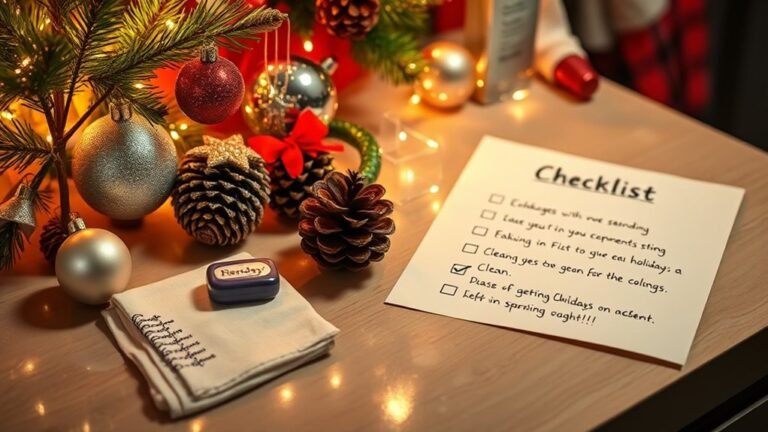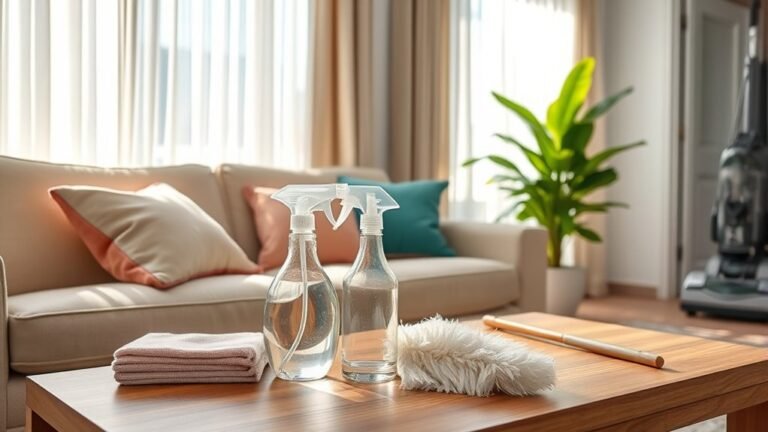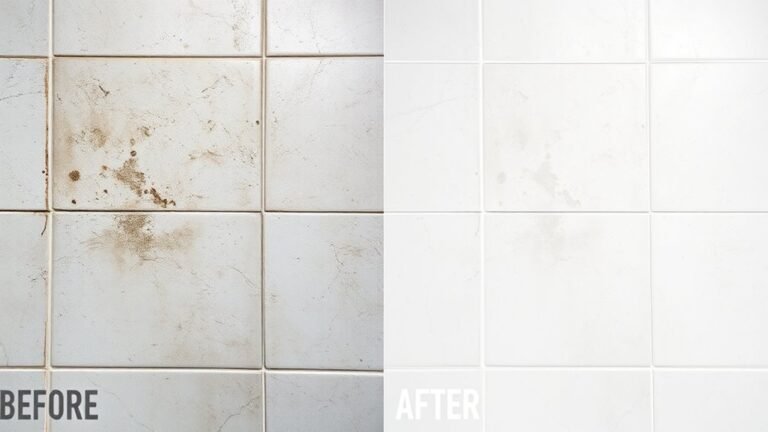Essential Tools for Cleaning Laminate
You’ll need a microfiber mop for gentle, effective dirt removal without excess water that can warp laminate. Pair that with a soft bristle broom or a vacuum set to hard floor mode to protect surface coatings from scratches. Use a spray bottle for controlled application of pH-neutral laminate cleaner, and keep soft cloths or gentle scrubbing pads handy for stubborn spots. Don’t forget protective mats to shield floors in high-traffic areas. Discover how each tool plays an essential role in maintaining your floor’s longevity.
Microfiber Mop
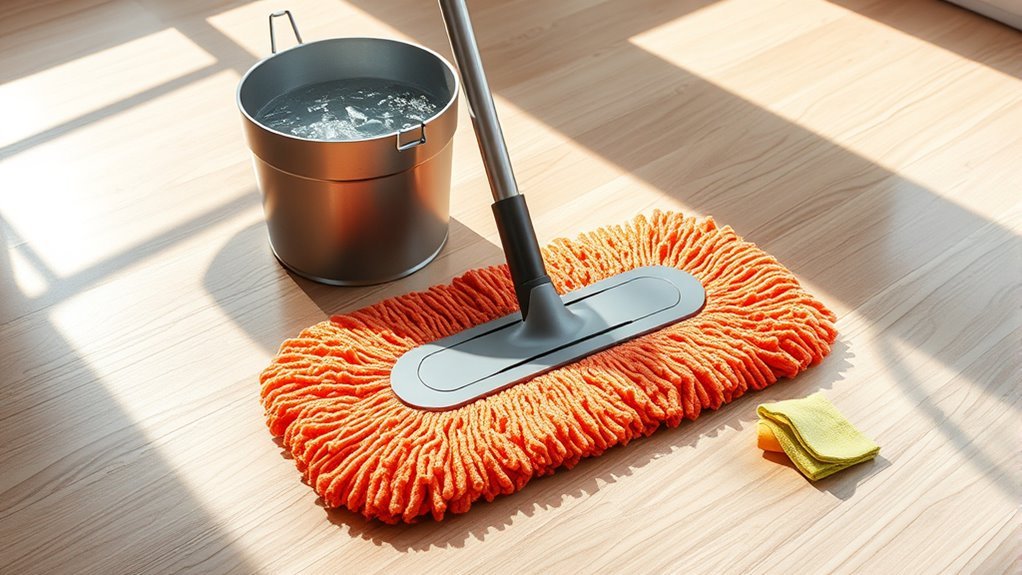
A microfiber mop offers an efficient, gentle way to clean laminate floors without causing damage. You’ll appreciate the microfiber advantages, such as superior dust and dirt capture due to its dense fiber structure. This reduces the need for harsh chemicals, preserving your floor’s finish and promoting healthier indoor air quality. When using microfiber mops, adopt cleaning techniques like damp mopping with minimal water to prevent warping. Avoid soaking the mop head; instead, wring it out thoroughly before use. Regularly rinse and replace mop pads to maintain effectiveness and prevent streaking. This method guarantees you maintain the freedom to enjoy spotless floors without risk or excessive effort, combining functionality with protection for your laminate surfaces. To ensure safety and effectiveness, choose eco-friendly cleaning products that avoid harsh chemicals commonly found in traditional cleaners.
Soft Bristle Broom
While microfiber mops excel at capturing fine dust and dirt, you’ll find that a soft bristle broom offers a straightforward approach to quickly sweep away larger debris from laminate floors. Choosing the right broom type and materials is essential for effective cleaning without damaging the surface. Soft bristle brooms feature flexible, gentle fibers that prevent scratches and protect laminate coatings. When selecting a broom, consider:
Soft bristle brooms quickly sweep larger debris while protecting laminate floors from scratches and damage.
- Synthetic bristles for durability and moisture resistance
- Natural bristles for eco-friendly, gentle sweeping
- Angled broom heads for better reach into corners and edges
Using a soft-bristle broom helps avoid the abrasive effects that can compromise the protective wear layer of laminate flooring.
Vacuum Cleaner With Hard Floor Setting
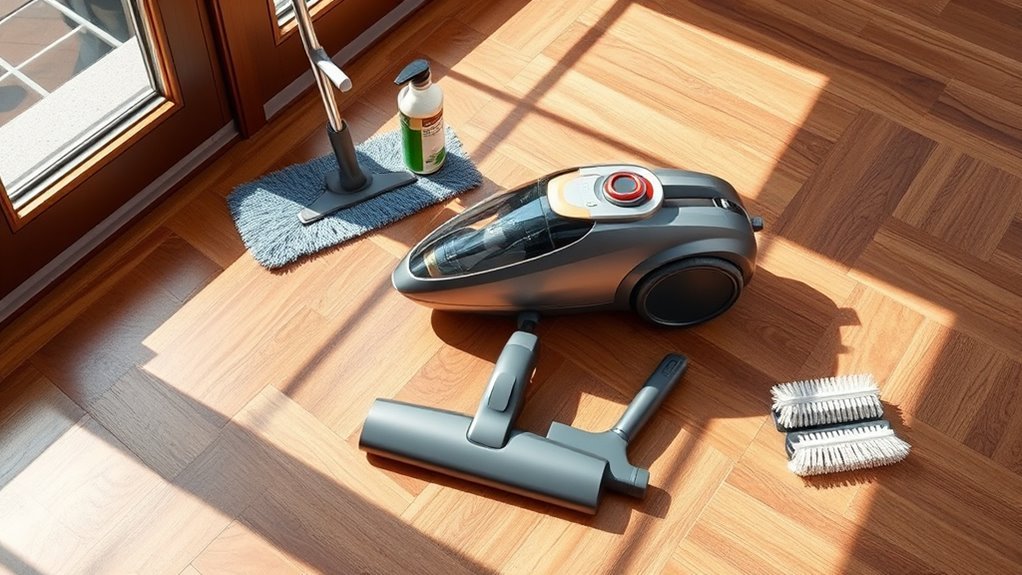
Since laminate floors require gentle care, using a vacuum cleaner with a hard floor setting guarantees you remove dust and debris without causing scratches. Hard floor settings deactivate rotating brushes or switch to softer modes, preventing surface damage while maintaining ideal suction. This feature is essential for preserving your laminate’s finish and extending its lifespan. To guarantee consistent performance, follow vacuum maintenance tips like regularly emptying dustbins, cleaning filters, and checking for blockages. Avoid using beater bars or harsh attachments, as they can degrade the flooring. Choosing a vacuum with adjustable hard floor settings empowers you to clean efficiently without compromising your laminate’s integrity, giving you freedom from worry and maintaining a pristine environment effortlessly. Additionally, regular vacuuming is crucial as it prevents dirt build-up that can scratch and dull laminate surfaces over time.
Spray Bottle for Cleaning Solutions
After vacuuming with the proper hard floor setting, you’ll want to apply cleaning solutions evenly without over-saturating your laminate. A spray bottle with an adjustable spray nozzle offers precise control over the amount of liquid dispensed, preventing damage from excess moisture. Using your own homemade cleaners, you can tailor solutions to your preferences, ensuring safety and effectiveness. Choose a spray bottle that:
Use an adjustable spray bottle for even, controlled application of homemade cleaners, protecting your laminate floors from moisture damage.
- Allows for a fine mist or targeted spray to control application
- Is made of durable, chemical-resistant material
- Features an ergonomic design for comfortable use
This tool provides freedom to customize your laminate cleaning routine efficiently. Precise application minimizes risk and maximizes results, making the spray bottle an essential element in your laminate cleaning arsenal. To maintain the longevity of your cleaning tools, regular maintenance and proper storage in dry, cool places is recommended to prevent damage and ensure effectiveness.
Laminate Floor Cleaner
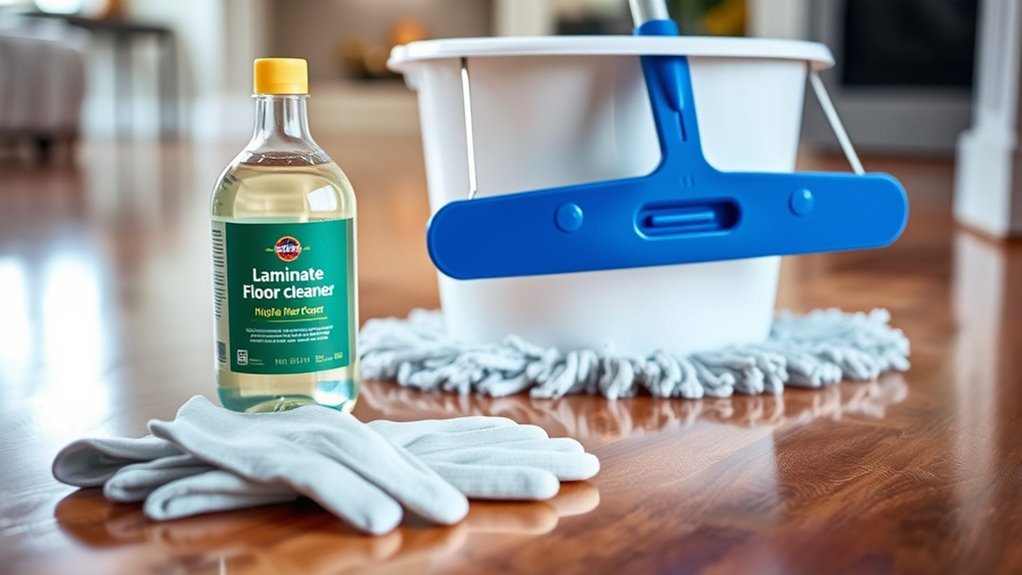
Choosing the right laminate floor cleaner is crucial to maintaining your floor’s durability and appearance. You want a product that effectively removes dirt without damaging the surface or leaving residue. Opt for eco friendly cleaners to safeguard indoor air quality and support laminate floor maintenance sustainably. Avoid harsh chemicals like bleach or ammonia.
Proper identification of your floor type and understanding cleaning surface traits helps in selecting the safest and most effective cleaning approach.
| Cleaner Type | Benefits | Considerations |
|---|---|---|
| pH-neutral cleaners | Safe, non-damaging | May require frequent use |
| Vinegar solutions | Eco friendly, affordable | Use diluted to avoid damage |
| Commercial products | Specialized formulas | Check for eco certifications |
Selecting the proper cleaner guarantees long-lasting laminate beauty and freedom from frequent repairs.
Soft Cloths and Towels
Soft cloths and towels play a critical role in maintaining laminate floors without causing scratches or streaks. When selecting these fabrics, prioritize softness and absorbency to protect the floor’s finish during cleaning techniques. Avoid abrasive materials that compromise surface integrity.
Choose cloths with proven fabric durability; microfiber towels are ideal due to their gentle yet effective cleaning capability. Their high absorbency guarantees quick drying, reducing moisture damage risk. Maintain freedom in your cleaning routine by using:
- Lint-free cloths to prevent residue buildup
- High-quality microfiber for maximum dirt capture
- Durable fabrics that withstand frequent washing
Using microfiber cloths helps trap dirt and reduce streaks, ensuring a cleaner and more polished surface.
Bucket for Water and Cleaning Solution
A sturdy bucket is essential for mixing and holding the water and cleaning solution you’ll use on laminate floors. Choose one with a durable build and a comfortable handle for easy maneuvering. The water temperature matters: lukewarm water optimizes the cleaning solution’s effectiveness without damaging the laminate surface. Avoid hot water, which can warp the flooring. Measure the cleaning solution accurately, following manufacturer guidelines, and mix it thoroughly in the bucket to guarantee consistent performance. Using the right bucket allows you to control the ratio of water to cleaning solution, maintaining a balance that cleans efficiently while preserving your floor’s finish. This tool gives you the freedom to clean confidently, knowing you’re using the correct water temperature and solution strength every time. It is important to use a pH-neutral laminate cleaner in your solution to preserve the floor finish and avoid damage.
Gentle Scrubbing Pads
Gentle scrubbing pads provide the necessary abrasion to remove dirt and stains without damaging laminate surfaces. When you employ gentle scrubbing techniques, you maintain the integrity of the laminate finish while achieving a thorough clean. Choosing effective cleaning materials like non-abrasive pads is essential. Here’s what you should consider:
- Use pads labeled as non-scratch or safe for laminate to avoid surface degradation.
- Opt for synthetic fibers that balance firmness and softness to lift grime without abrasion.
- Avoid steel wool or harsh scouring pads that can etch or dull the laminate.
Additionally, incorporating eco-friendly cleaning products with gentle pads supports both effective cleaning and environmental safety.
Protective Floor Mats
You’ll want to use protective floor mats to shield your laminate from scratches, moisture, and dirt buildup. Different types—like rubber-backed, carpeted, or cushioned mats—offer specific benefits based on your needs. Proper placement in high-traffic or vulnerable areas guarantees maximum protection and extends your floor’s lifespan. Choosing mats made from biodegradable materials can also help reduce environmental impact while protecting your flooring.
Benefits of Floor Mats
Although laminate floors are durable, protecting them from scratches, dirt, and moisture is essential to maintain their appearance and longevity. Using floor mats provides significant mats benefits by acting as a barrier between your laminate and potential damage sources. You’ll find that investing in the right mat types enhances your floor’s durability without restricting your freedom to move or decorate.
Floor mats help by:
- Trapping dirt and moisture before they reach the laminate surface
- Preventing scratches from shoes, furniture, or pet claws
- Reducing wear in high-traffic areas, extending floor life
Types of Protective Mats
Protective floor mats come in various materials and designs, each tailored to specific needs for laminate flooring care. Choosing the right mat materials and mat sizes guarantees durability and effective protection. You’ll find options designed to resist moisture, trap dirt, and reduce scratches while maintaining freedom of movement.
| Mat Material | Durability | Common Sizes (inches) |
|---|---|---|
| Rubber | High | 24×36, 36×48 |
| PVC | Medium | 18×24, 30×40 |
| Polypropylene | High | 20×30, 35×50 |
| Felt-backed | Medium | 24×36, 27×45 |
Consider mat materials that suit your environment and mat sizes that cover high-traffic areas without restricting your space.
Proper Mat Placement
Choosing the right mat material and size is only part of maintaining your laminate flooring’s integrity. Proper mat placement is critical to maximize protection and reduce wear. You’ll want to strategically position entry mats and other mat types where dirt and moisture first contact your floor. Place entry mats outside and inside doorways to trap debris before it spreads. Additionally, consider these placement tips:
- Use mats at all main entrances to prevent tracking.
- Position mats in high-traffic zones to shield vulnerable areas.
- Avoid overlapping mats, which can create tripping hazards or damage laminate.
Frequently Asked Questions
Can I Use Vinegar to Clean Laminate Floors?
You can use vinegar to clean laminate floors, but you should dilute it well to avoid damage. Vinegar benefits include natural disinfecting and residue-free cleaning, making it a popular choice. However, its acidity can dull laminate surfaces over time. For cleaning alternatives, consider pH-neutral cleaners specifically designed for laminate. These options offer effective cleaning without risking the floor’s finish, giving you freedom to maintain your floors safely and efficiently.
How Often Should I Deep Clean Laminate Flooring?
You should schedule deep cleaning frequency for your laminate flooring every 3 to 6 months, depending on foot traffic and usage. This guarantees dirt and grime don’t build up, preserving the floor’s integrity. For ideal laminate maintenance tips, combine regular sweeping with occasional deep cleaning to extend lifespan and maintain appearance. Stick to manufacturer guidelines and avoid excessive water to prevent damage, giving you the freedom to enjoy a clean, durable floor.
Are Steam Mops Safe for Laminate Floors?
You might think steam mops offer quick, chemical-free cleaning benefits, but they’re risky for laminate floor maintenance. The high heat and moisture can warp or damage laminate surfaces, compromising their protective layer. Instead, use a damp mop with a laminate-safe cleaner to maintain your floors’ integrity and freedom from damage. Steam mops aren’t recommended if you want to keep your laminate looking pristine and extend its lifespan effectively.
What Should I Avoid When Cleaning Laminate Floors?
Imagine you used bleach once, and your laminate floor lost its shine. You should avoid harsh chemicals and abrasive cleaners because they damage the protective layer, causing dullness and scratches. Instead, stick to pH-neutral cleaners specifically designed for laminate. Also, never soak the floor with water, as excessive moisture can cause swelling. By steering clear of these damaging substances and methods, you’ll keep your laminate floors looking pristine and lasting longer.
Can Pet Hair Damage Laminate Flooring?
Pet hair itself won’t damage your laminate flooring, but if left unchecked, it can trap dirt and grit that may scratch the surface over time. You’ll want to regularly remove pet hair using a vacuum with a soft brush attachment or a microfiber mop to maintain your floor’s integrity. Staying on top of pet hair keeps your laminate flooring looking pristine and prevents long-term wear caused by abrasive particles caught in the fur.



